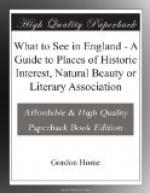Canterbury teems with interesting relics of the past, and weeks may be spent in its old-world streets, where one is continually coming across unexpected little bits of half-timber work, weather-beaten gables, and grotesque oak carving. The cathedral, whose “Bell Harry” or central tower seems to dominate the whole city, should be approached through Mercery Lane, at the corner of which are some slight remains of Chaucer’s hostelry, “The Chequers of Hope.” At the bottom of the lane the cathedral close is entered by the famous Christ Church Gateway, erected by Prior Goldstone in 1517. Once inside the close gate the visitor gets some idea of the amazing beauty of the structure, which is certainly unsurpassed by any other cathedral in the kingdom. The building exhibits almost every style of architecture, from the Norman work of William of Lens to the late Perpendicular of Prior Goldstone, and yet the work of composition and design has been so exquisitely carried out that there is no hint of any want of harmony in the magnificent whole. The interior is no less remarkable, the arches and vaulting of the nave being some of the most beautiful in existence. Becket’s shrine was despoiled at the Reformation, but the number of pilgrims who visited it may be imagined from the fact that the broad stone steps are worn hollow, and this only by the knees of his worshippers. The Angel doorway in the cloisters, by which the archbishop entered the sacred building pursued by his murderers, gives access on to the north-west or martyrdom transept. Here is shown the spot where the primate made his last stand and fell under the blows of the Norman knights. Another object of special interest is the tomb of Edward, the Black Prince, who died in the city in 1376. There is so much to see in and about the cathedral and its precincts, however, that a trustworthy guide-book is a sine qua non. The building is open from 9.30 to the end of evening service—the nave and two west transepts free; the choir and crypt, 6d. each person. Sketching orders, 2s. 6d. per day, and photographing orders, 5s. per day.
In the city itself the most interesting of the old churches is St. Martin’s, reputed to be the oldest in England (admission, 6d.). Here St. Augustine first preached Christianity before the cathedral was built. St. Martin’s Hill, near the church, should be noticed. It was over this ascent that Augustine with his Roman monks passed into Canterbury in 697.
In Monastery Street is the fine gateway of the once rich and powerful St. Augustine’s Abbey; and near it, not many years ago, was a fine example of Saxon work, known as Ethelbert’s Tower, which some of the intelligent busybodies of the time had removed with a battering-ram.
In Broad Street is the Hospital of St. John, with its quaint entrance and fine old timbered gateway.
The Grammar School, known as the King’s School, was founded at the close of the seventh century. The most remarkable portion of what remains of the old buildings is an almost unique Norman staircase.




